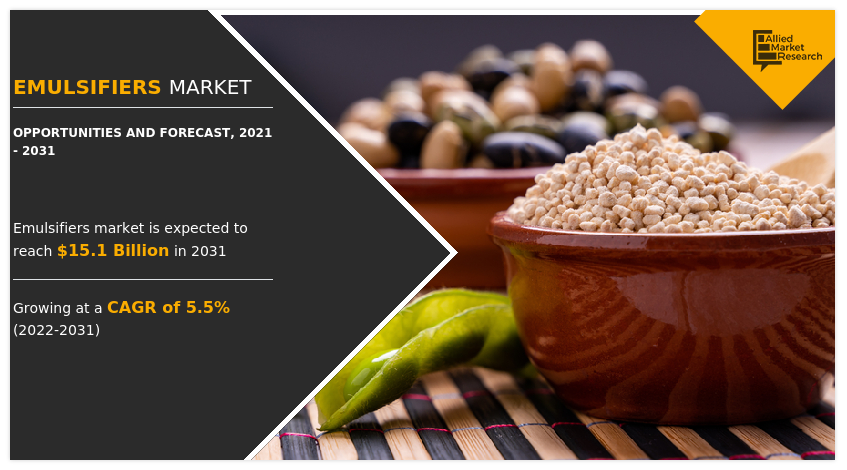According to a new report published by Allied Market Research, titled, “Emulsifiers Market,” The emulsifiers market size was valued at $8.9 billion in 2021, and is estimated to reach $15.1 billion by 2031, growing at a CAGR of 5.5% from 2022 to 2031.
Emulsifiers are Food and Drug Administration (FDA)-authorized food ingredients that aid in the combination of goods containing insoluble food components, such as oil and water. Emulsifiers are found in packaged and convenience foods such as mayonnaise, margarine, meats, ice cream, salad dressings, and chocolate. They can be synthesized or found naturally. Many emulsifiers used today are hydrocolloids, which are naturally produced. Hydrocolloids are thickening chemicals that maintain the structure, texture, taste, and shelf life of numerous food items. Owing to the sheer food texture and consistency generated by hydrocolloids, they are commonly referred to as gums. Emulsifiers derived from plants, animals, and aquatic sources are examples of hydrocolloids. Hydrocolloids derived from plants include locust bean gum, carrageenan, pectin, and starch, whereas hydrocolloids derived from animals include crustacean shell chitosan. Hydrocolloids, such as xanthan gum, may also be derived from microbial sources, and food ingredients such as mustard, oil, salt, egg yolk, and vinegar can also be used as emulsifiers. Some hydrocolloids have been proven to decrease cholesterol, enhance insulin function, act as prebiotics, and are high in fiber.
Download Sample Report: https://www.alliedmarketresearch.com/request-sample/17343
With the evolution of technology, industrial businesses are adopting new sources of emulsifiers to improve product quality, boost efficiency, and minimize processing time. For decades, emulsion technology has been used in the food industry to produce a wide range of products such as homogenized milk, creams, dips, dressings, sauces, desserts, and toppings. Significant advances in emulsion science, on the other hand, have lately resulted in revolutionary approaches for improving food quality and usability. Silica particles, wheat protein microgels, pea protein microgels, and other new advancements in emulsion technologies are assisting producers to bind the chemicals effectively, lowering the time required to complete the process, which is expected to fuel the emulsifiers market growth.
Starch is the most common type of carbohydrate consumed by humans. It is a plentiful, inexpensive, naturally occurring, and easily accessible basic food. Textiles, medicines, paper manufacturing, bioplastics, and many more sectors use it extensively. The use of starch has been witnessed to increase significantly in food processing, where it functions as both a stabilizer and an emulsifier to improve food quality. Long-term stabilization in food emulsion systems is ascribed to starch-based emulsifiers derived from micro and nanoparticles, hence increasing food structure and storage stability. These starch-based emulsifiers were created using a variety of processes, including hydrolysis, cold gelatinization, dissolution-precipitation, sedimentation, encapsulation, and the addition of hydrophobic components. As a result, starch-based emulsifiers that successfully bind emulsion interfaces are produced. These emulsifiers effectively stabilized pickering emulsions, which are well-known for their high stability. The increase in usage of starch-based emulsifiers is expected to provide emulsifiers market opportunity for growth.
The global emulsifiers market is segmented into source, application, and region. On the basis of source, the market is categorized into plant, animal, and synthetic. By application, it is fragmented into food & beverages, personal care & cosmetics, pharmaceuticals, and others. Region wise, it is analyzed across North America (the U.S., Canada, and Mexico), Europe (Germany, UK, France, Italy, Spain, and the rest of Europe), Asia-Pacific (China, India, Japan, Australia, South Korea, and rest of Asia-Pacific), and LAMEA (Brazil, Turkey, South Africa, Argentina, and rest of LAMEA).
For Purchase Enquiry: https://www.alliedmarketresearch.com/purchase-enquiry/17343
The players operating in the global emulsifiers industry have adopted various developmental strategies to expand their emulsifiers market share, increase profitability, and remain competitive in the emulsifiers industry. The key players profiled in this report include Archer Daniels Midland, AkzoNobel N.V., BASF SE, Cargill, Inc., Clariant AG, DuPont, Evonik Industries, Kerry Group, Koninklijke DSM N.V., and Solvay S.A.
Key findings of the study
- According to emulsifiers market analysis, on the basis of source, the plant segment is projected to witness the highest CAGR of 6.6%, in revenue terms, during the forecast period.
- Depending on application, the pharmaceuticals segment is expected to grow at a significant CAGR during the emulsifiers market forecast period.
- According to emulsifiers market trends, U.S. was the largest country, in terms of revenue generation, in 2021.
- Asia-Pacific is anticipated to exhibit the highest CAGR of 7.1% from 2022 to 2031.
Allied Market Research (AMR) is a full-service market research and business-consulting wing of Allied Analytics LLP based in Portland, Oregon. Allied Market Research provides global enterprises as well as medium and small businesses with unmatched quality of “Market Research Reports” and “Business Intelligence Solutions.” AMR has a targeted view to provide business insights and consulting to assist its clients to make strategic business decisions and achieve sustainable growth in their respective market domains. AMR offers its services across 11 industry verticals including Life Sciences, Consumer Goods, Materials & Chemicals, Construction & Manufacturing, Food & Beverages, Energy & Power, Semiconductor & Electronics, Automotive & Transportation, ICT & Media, Aerospace & Defense, and BFSI.
We are in professional corporate relations with various companies and this helps us in digging out market data that helps us generate accurate research data tables and confirms utmost accuracy in our market forecasting. Each and every data presented in the reports published by us is extracted through primary interviews with top officials from leading companies of domain concerned. Our secondary data procurement methodology includes deep online and offline research and discussion with knowledgeable professionals and analysts in the industry.
